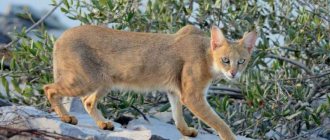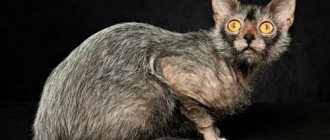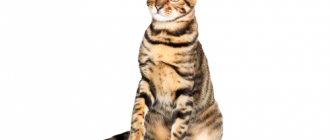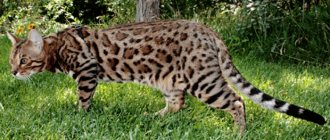Characteristics of appearance
Jaguarundi is a South American representative of big cats, although the size of this animal is quite modest in comparison with its close relatives - pumas. The Jaguarundi is slightly larger in size than a large cat. The height of the cat at the withers reaches 35 cm, length is about 80 cm, tail – 60 cm, weight – up to 10 kg. Externally, cats of this breed look like this:
- The head is small, slightly flattened in shape with a short muzzle.
- The eyes are rounded, their color is tea-brown.
- The ears are rounded at the tip, without any markings on the back side. The absence of spots on the back wall of the ear is considered a unique feature of the jaguarundi, since all representatives of the cat world, both large and small, have such light spots of different sizes.
- The body is elongated, flexible, with a well-developed muscle corset.
- The tail is long and thin, covered with thick and dense hair.
- Wool – thick, short and smooth. The color is uniform, without any color transitions or spots. Small inclusions can only be found in adult jaguarundis. Small spots of color, slightly different in color from the main shade of the coat, may be present on the belly and face of the animal. Color – brown, black, rich red, gray.
Thanks to its well-developed muscles, the cat is endowed with incredible grace and flexibility. The smoothness of her movements is absolutely silent. If we characterize the appearance of a jaguarundi, we can say that by the flexibility and plasticity of the body it is a cat, by its muzzle it is an otter, and by its small, short and powerful legs it is a weasel.
To get or not to get a kitten?
Many people want to have an attractive and unusual animal at home. But before you buy a kitten, you need to understand the following:
- - exotics are expensive, the price of a kitten reaches 20-25 thousand dollars, this is the most expensive cat in the world;
- — the veterinarian may refuse to examine and treat the predator;
- — the instinct of a predator, even one raised at home, can present unpleasant surprises;
- - the desire for loneliness and love for large territories can create problems for the animal and its owner.
IMPORTANT! Whether or not to get an exotic kitten should be decided not based on fashion, but by listening to the voice of reason and weighing your options.
Where does the animal live?
In the wild, the South American cat inhabits the territories of the Southern and Central parts of America, and the jaguarundi's favorite habitats are Texas, Mexico, Uruguay and Argentina.
The animal prefers to settle in dry forests and pastures with a lot of wet greenery. Graceful cats are often spotted in the tropics.
Jaguarundis love to climb somewhere higher, living in areas up to 3000 meters above sea level.
Absolutely comfortable living conditions for jaguarundi are lake shores, swampy regions, savannas with sloping meadows of tall cacti.
Spread range
Geographical distribution
Photo: Wikipedia
The ancestors of the jaguarundi likely evolved in Eurasia and migrated to the Americas across the Bering Landscape about 16,000 years ago . These wild cats now have a wide geographic distribution, extending from southern Texas to the eastern and western lowlands of Mexico, through the inter-Andean valley of Peru, into southern Brazil and Paraguay, into the provinces of Buenos Aires and Rio Negro in Argentina. There have been several recorded sightings of the jaguarundi in Florida, and a small population here may have resulted from introduction (accidental or deliberate relocation) by humans.
- Biogeographic regions: ocarctic, neotropical
Habitat
These cats inhabit a wide range of open and closed habitats: from wet grasslands, plains near bodies of water, dry bushes and swampy savannas to virgin tropical forests. Access to dense ground cover and dense ground vegetation appears to determine habitat suitability for the jaguarundi. They prefer forest edges and secondary scrub, although this may simply be where they are most often found.
Photo: Happy Hootenanny
These cats are rarely found deep in forests, but often live in open lowlands near shelters. There have been reports of jaguarundis found at altitudes ranging from 2,000 to 3,200 meters above sea level.
- Habitat: temperate, tropical
- Terrestrial Biomes: Savannah, Wet Grassland, Chaparral, Coastal, Rainforest, Shrub
Home range
The personal territories of jaguarundis vary greatly between populations. A radiotelemetry study in Belize showed that the habitats of these cats are enormous . The territories of males and females vary significantly: 88-100 km² for adult males and 13-20 km² for adult females. Male ranges overlap by less than 5%. Both sexes periodically use different areas within their widely dispersed ranges, rather than regularly patrolling the boundaries.
In Brazil, jaguarundis have a very low density of 1-5 cats per 100 km², but in Mexico their population is estimated at 20 cats per 100 km². Increasing numbers of cats in the population result in smaller home ranges and more overlapping territories.
Photo: Miroslav Heran
Population density also depends on habitat. For example, in the Brazilian savannas, home ranges for females and males ranged from 18 to 40.2 km2, whereas in the forest-farmland mosaic they ranged from 1.4 to 34.9 km2. By comparison, a study conducted in the Mexican plains found that males' personal territories were 9.6 km2 and females' territories were 8.9 km2, with significant overlap between the sexes.
Jaguarundi subspecies
Zoologists distinguish 7 different subspecies of jaguarundi, which were discovered at different times:
- Puma yagouaroundi - lives in the Amazon and Guyana, inhabiting forests.
- Puma yagouaroundi eyra - inhabits Brazil, Argentina and Paraguay.
- Puma yagouaroundi cacomitli - its habitat covers the southern region of Texas and the pampas in Mexico.
- Puma yagouaroundi tolteca - inhabit the North American part of Mexico and Arizona.
- Puma yagouaroundi melantho – Peru and Brazil.
- Puma yagouaroundi ameghini - western Argentina.
- Puma yagouaroundi panamensis – Nicaragua.
These subspecies do not differ in appearance, only their habitats differ.
Origin of the species and description
Photo: Jaguarundi
Jaguarundi is a carnivorous mammal belonging to the cat family. This animal is original in many of its manifestations. Outwardly, it has collected features belonging to several animals. The structure of the elongated body of the jaguarundi resembles predators belonging to the family of mustelids and civets. It shows features of weasel and Madagascar fossa. Many claim that the rounded muzzle and rounded ears of this feline are very reminiscent of an otter. Others see in it signs of a puma and a jaguar at the same time.
Interesting fact: Jaguarundi has a unique set of chromosomes. She, like European cats, has 38 of them, which is not typical for small cats living in the same territories as jaguarundi, they have only 36 chromosomes.
Jaguarundi fur can be of the following colors:
- gray;
- deep red;
- brown.
It was because of the differences in color that some time ago these predators were divided into two varieties: jaguarundi and air. Then scientists found out that these cats successfully mate with each other, giving birth to both red and gray kittens. Thanks to this observation, the division of animals into two varieties was considered erroneous and the jaguarundi was classified as a member of the puma genus. Zoologists have identified seven subspecies of jaguarundi, discovered in different years. Outwardly, they are all identical and differ only in their places of permanent residence.
Video: Jaguarundi
Scientists believe that jaguarundis were the first to be tamed by people in ancient times to protect food from rats and mice. Cats deftly dealt with not only rodents, but also reptiles and various insects that could harm humans. In many Indian tribes, jaguarundis lived as pets. They were distinguished by their stern character and aggressive attitude towards strangers, and they carefully defended their owners and territory.
How they behave and hunt
These beautiful wild cats are loners in life; they gather in pairs or small groups only during the mating period. About 20 km2 is allocated for each individual. Females often live in close proximity to males, and they do not at all mind such close proximity.
A distinctive feature of these cats from other feline representatives of the wild is their hunting time. They are especially active in the first half of the day, reaching their hunting climax at noon. The hunting grounds are lowlands, but if a jaguarundi spots a tasty bird on a high branch, it will not be difficult for it, quieter than a falling feather, to achieve the hunting goal with one graceful leap of its muscular body.
Jaguarundi is the only representative of the cat world that, during a hunt, freezes in the process of tracking prey and stands on its hind legs.
A cat can sit in this position for a very long time, waiting for the right moment to attack. Stretching out into an even string, the cat sits in the thickets, sticking out only his head. At the most favorable moment, the jaguarundi attacks - lightning fast and mercilessly, without giving the victim the opportunity to come to his senses.
Cats also love to eat fish, showing the talent of an avid fisherman. The ability to swim and lack of fear of water allows the jaguarundi to swim long distances.
Like all cats, jaguarundi always mark their earthen possessions, irrigating the grass with drops of urine, making scratches on the bark of trees with their claws. Jaguarundis are fearless. If an animal lives near a human settlement, at night the cat does not hesitate to come closer and destroy farmland with poultry.
The Jaguarundi is an amazing animal in every way. A wild cat not only knows how to meow, but also qualitatively reproduces various sounds of wild nature; it can delicately repeat a bird’s singing, whistling, purring, and it can also howl.
In total, the animal's vocal range includes 13 different sounds found in the wild. This feature of the jaguarundi has a dual function - wild cats use it for camouflage during hunting and for their protection if an enemy suddenly approaches and poses a danger to the life of the wild cat.
Enemies
In the wild, the jaguarundi has many enemies, and this is due to the animal’s modest size. The jaguarundi is afraid of and avoids encounters with large predators, coyotes, ocelots and close species relatives of the puma.
The animal will never engage in a skirmish with its enemy, preferring to hide in dense thickets in case of high danger. But if a meeting with a large predator could not be avoided, it will be a bloody fight to the death, and, unfortunately, most often not in favor of the jaguarundi.
Communication and perception
Jaguarundi have good hearing , the upper limit of audibility is 100 kHz. These animals have a unique characteristic that is very unusual among cats: they use no less than thirteen different sounds to communicate, ranging from purrs to whistles and bird chirps. During reproductive receptivity, the female rolls over onto her back and makes a faint whine.
Jaguarundi is a territorial animal . It marks the boundaries of its home range in several ways: spraying urine, scraping wood and ground with its claws, wiping objects with its head and neck. If personal space is violated, the animal begins to loudly hiss and/or spit.
Photo: Animal Vogue
The tactile channel of perception is involved in communication between kittens, a mother and her offspring, as well as between sexually mature couples. The female screams loudly during mating, and the male gently bites her on the neck.
What does a jaguarundi prefer to eat?
The modest size of a wild cat does not allow it to hunt large animals. The diet consists of small game, the weight of which does not exceed 1 kg. It is rare that a jaguarundi manages to catch a large trophy - an opossum or an armadillo. The animal's daily menu depends on the characteristics of their habitat - the diet may include reed hamsters, chinchillas, and guinea pigs.
The South American cat, which lives in the northern states, feeds on the Florida rabbit. Individuals, whose habitat extends to savannas with thorny thickets, feed mainly on small and medium-sized reptiles - iguanas and lizards; small birds are also present on the menu.
Jaguarundi is a real sweet tooth who is not averse to eating fruits and berries - figs, bananas and dates.
And, of course, the animal uses farmland to enrich its diet, bringing their owners a lot of worry and expense.
Save Status
Jaguarundi fur has no commercial value , so the animals are not hunted for their pelts. But these cats are easily tamed and become good pets, so catching jaguarundi kittens is quite a profitable business for poachers. However, their captive breeding still leaves much to be desired.
These animals have the lowest conservation priority and are therefore not listed on the IUCN Red List.
Because little is known about the jaguarundi, its status must be periodically reviewed. There is an urgent need for further research into its demography and habitat to identify threats and their consequences, and to enable adequate conservation measures to be taken. But it is already obvious that the intensive transformation of savannas into industrial agricultural landscapes will negatively affect the jaguarundi population, but it is not yet clear how much.
Although the actual population size is unknown, hunting of jaguarundi is already prohibited in Argentina, Belize, Bolivia, Colombia, Costa Rica, French Guiana, Guatemala, Honduras, Mexico, Panama, Paraguay, Suriname, Uruguay, United States and Venezuela. In Peru, hunting is regulated. But in Brazil, Ecuador, El Salvador, Guyana or Nicaragua, these wild cats are not protected by law.
Life in captivity
For the first time, the jaguarundi began to be tamed by the Indian tribes that lived in Panama. Wild cats were used as good and faithful guards against rats and mice. But as soon as a person began to engage in housekeeping, it became impossible to keep a jaguarundi as a guard cat, because the animal began to hunt poultry. Since then, these graceful cats have become enemies for farmers who raised poultry.
Today, the jaguarundi has again begun to gain popularity as a domestic, exotic animal. Wild guts feel comfortable in private and public zoos. A person who decides to have a jaguarundi as a pet should be prepared for the fact that a lot of effort will have to be made to provide the cat with conditions that are as close as possible to its natural habitat.
You cannot keep an animal in an apartment. Only a private house with a large local area is suitable for keeping a wild cat, so that the jaguarundi can feel as free as in its natural habitat. The diet of a domestic jaguarundi is raw rabbit and chicken meat, fresh unsalted fish.
You should not give your animal fatty meats, since such a product is atypical for the animal’s body, because the digestive system will not be able to digest it normally. It is strictly forbidden to give your cat industrial food (wet and dry). Once a week you can pamper your pet with bananas and dates.
It is important to support the animal’s hunting instinct so that it moves fully and actively, which will have a positive effect on the animal’s immune system and prevent the development of many diseases. In the territory where the jaguarundi lives, you need to release one poultry or small rodent at least once a week, for which the pet will start an exciting hunt.
Eating habits
These carnivores hunt primarily on the ground. Their diet typically consists of small rodents, birds, lizards, amphibians and reptiles, which are also hunted by coyotes, mountain lions, bobcats and foxes. Prey weighing more than 1 kg, such as rabbits, opossums and armadillos, are not unusual for feral cats. Jaguarundis also hunt poultry throughout much of their range. They sometimes feed on chinchillas, iguanas, guinea pigs, bristly rats, monkeys and fish.
Like other felids, the jaguarundi can consume small amounts of arthropod insects and vegetation (leaves and fruits). They were also seen eating a small deer, but this could have been carrion.
Photo: ZooChat
The average weight of vertebrate prey per day is 400 grams. In captivity, the average daily food intake of meat (dead and live chickens) is about 400-450 grams.
Reproduction
In the wild, jaguarundis lead a rather hidden life, so observing them for a long period of time is quite problematic. In this regard, zoologists do not have enough information about all the details of the mating season of wild cats. It is known that the period of puberty occurs late in these animals, when the animal is about 3 years old.
Males, as soon as the mating period begins, come as close as possible to the territory where the females live. At first, the female may respond to the male’s advances quite aggressively, not letting him get close to her. In the process of conceiving new kittens, the male growls loudly, and at the end of the process he sinks his teeth into the female’s withers.
There is no one specific period when jaguarundi mating occurred. The breeding period depends entirely on the climatic conditions in which the animal lives. Individuals inhabiting the tropics can mate in any season of the year. Wild cats living in areas with a temperate and fairly cool climate choose March and September for mating.
In captivity, animals breed twice a year. The duration of pregnancy is about 60-75 days. The number of kittens in one litter is 4. Despite the fact that puberty occurs quite late in cats, the development of kittens occurs rapidly.
When a baby turns 3 months old, his digestive system can already digest food of animal origin. Offspring at this age can gradually begin to hunt, first going out into the open with their mother. As they quickly mature, they begin to hunt game on their own, demonstrating natural hunting skills and instincts.
Find out what other breeds of wild cats exist:
- pampas cat;
- clouded leopard;
- Canadian lynx.
Content Features
What should the diet be like?
The fruits of the fig tree are a favorite delicacy after meat.
Since jaguarundis are carnivores, they prefer meat. The animal will not refuse rodents, lizards, and various insects. However, it is important not to forget that the wild cat is almost the only one who prefers plant foods. You will need to include grapes and bananas in your pet's menu. We especially love this representative of the feline figs.
Subtleties of care
The behavior pattern of the owners is directly related to what kind of jaguarundi will grow up: a wild predator or an affectionate pet. It is important to take care of the feeding process. It is recommended to build it as a kind of communication ritual. By starting to raise a wild cat from a young age, you can get an obedient animal who will understand that for good behavior he will receive his favorite treat. As the wild cat grows up, care will become easier. It is imperative to remove the claws of a wild cat, as it can seriously injure members of the household.
Species protection
The jaguarundi is not the subject or purpose of hunting, since the animal’s fur and its meat have no value or interest. Nevertheless, the issue of extermination of the jaguarundi is acute, since the population size has rapidly decreased in recent years.
The decrease in the number of mini-puma individuals is due to the fact that they are hunted by people or they cannot resist their enemies. Man hunts this wild cat only for the purpose of protecting his farmland from the encroachments of a wild animal.
In addition, the decline in population, especially in the Texas region, is due to the fact that people are rapidly expanding their habitats, displacing jaguarundis from their natural habitat. In recent years, zoological scientists have become concerned that these unusual wild cats are becoming increasingly rare.
Despite this, the jaguarundi is a wild cat, which, unlike many of its fellow tribesmen, is not considered an endangered species and is not protected by the states whose territories are included in its habitat. But due to the catastrophically decreasing number of jaguarundi in recent years, it is likely that the breed will soon fall under the protection of the authorities.
Lifestyle and behavior
This cat is difficult to trap due to its cowardice and secrecy, so little detailed information has been collected about the jaguarundi's temperament. It is known that they are predominantly terrestrial animals , although they can also move through trees with great agility and speed, especially when being pursued. These cats sometimes chase monkeys, jumping from branch to branch, while their long tail helps them balance. Jaguarundi are good jumpers. When catching birds, they can jump up to two meters high. Like the fishing cat, the jaguarundi is an excellent swimmer.
Photo: João Vitor Andriola
Unlike most wild cats, the jaguarundi is active during the day . He hunts mainly in the morning and evening. Activity peaks between 10:30 and 11:30 and 14:00 and 16:00, with very little activity after sunset. This behavior helps minimize competition with the ocelot, which is active at night. At night, jaguarundis rest in the trees.
These cats lead a solitary lifestyle , although they are able to tolerate the presence of other individuals of their species. They travel and collect food in pairs mainly during the breeding season.
Jaguarundi is a wild cat similar to a large marten. Description of the breed, photo
Jaguarundi on a branch
A wild cat can come in many colors and is similar in appearance to some animals. Researchers have encountered grayish-brown and bright red jaguarundis. It was the color that made it possible to distinguish between two types of animals: airs and jaguarundi. After some time, it was discovered that both species mated and gray or fiery red feral kittens were born. Subsequently, the species were combined and assigned one genus, puma.
What subspecies of jaguarundi are there and where do they live?
Habitat: South and Central America, as well as the northwestern part of Argentina and the coast of Mexico. Much less common in Texas and Arizona. There are eight known varieties of jaguarundis with different habitats, differing in length of fur, color, skull structure and body size:
- Felisyagouaroundi yagouaroundi – found in the Amazon forests and tropics of Guyana;
- tolteca - have been seen in Mexico and Arizona;
- fossata - found in Honduras and Mexico;
- panamensis - found in places from Ecuador to Nicaragua;
- melantho – common in Brazil and Peru;
- eyra (Eira) - common in Argentina, Paraguay and Brazil;
- ameghini - found in Argentina.
Like any other cat, the jaguarundi marks its territory by leaving its specific smell of urine or feces on trees and bushes.











